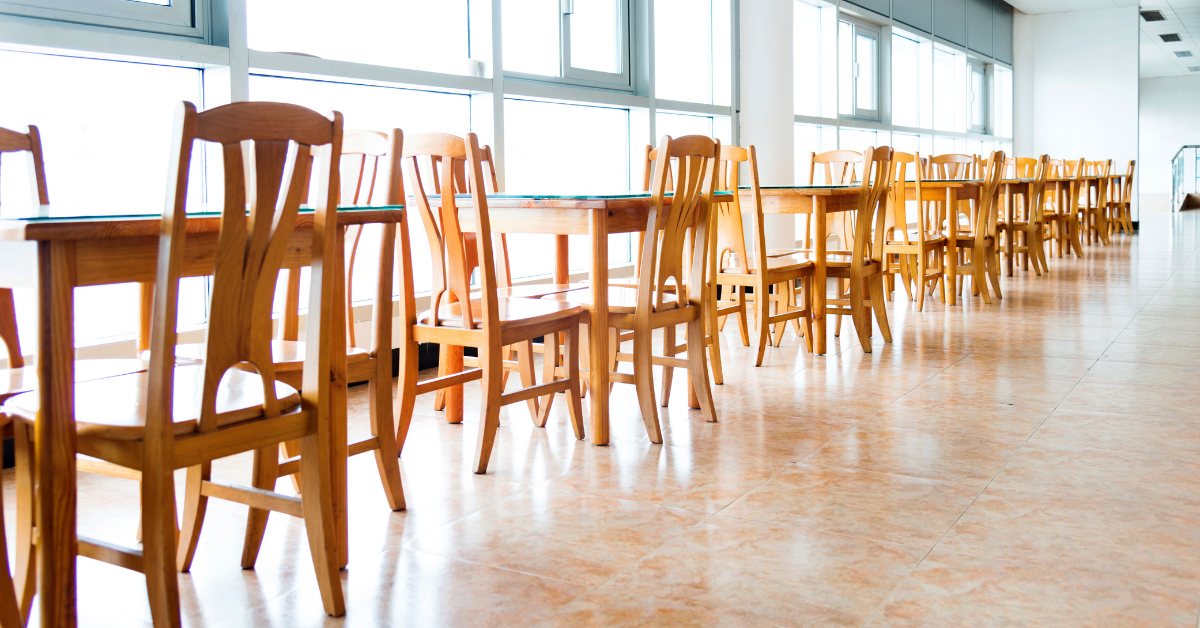When choosing cafeteria flooring, a visually appealing design is undoubtedly a bonus, but selecting the perfect flooring for your cafeteria involves more than meets the eye.
Whether you’re curating a dining space within a corporate office, an educational institution, a healthcare space, or an assisted living community, the decisions you make about your cafeteria flooring are essential for withstanding the daily hustle and bustle.
From design nuances to practical considerations, we’re here to guide you through the process of making an informed choice that will stand the test of time.
Let’s get started!
Top 4 Materials for Cafeteria Flooring
Rubber Flooring
When it comes to cafeteria flooring, we often find ourselves recommending rubber flooring as our top choice. This versatile material offers the perfect blend of safety, durability, and maintenance.
Here’s why rubber flooring might just be the perfect fit for your cafeteria:
- Excellent slip resistance for enhanced safety
- Superior sound absorption, creating a quieter and more pleasant dining environment
- Minimal water absorption, making spills and cleaning a breeze
- Effortless maintenance with simple sweeping and mopping
- Inexpensive, perfect for a budget
- Lifespan ranging from 10 – 20 years
Vinyl Flooring
When it comes to adding a touch of customization to your cafeteria’s interior design, vinyl flooring is a fantastic contender, especially if you still want to keep maintenance and durability in mind.
Here’s why it stands out in the world of cafeteria flooring:
- Vast array of designs, colors, and textures for customizable aesthetics
- Water-resistant properties to repel spills and stains
- Durability against heavy foot traffic and furniture movement
- Low maintenance and easy cleaning, perfect for busy cafeterias
- Budget-friendly
- Lifespan of 10 – 20 years
Keep in mind, while vinyl is cost-effective and visually stunning, it might lack the same level of cushioning and noise absorption as rubber flooring. Nevertheless, when it comes to customization and visual appeal, vinyl takes center stage.
Linoleum Flooring
For those who prioritize sustainability, linoleum flooring is the go-to choice for your cafeteria. Made from natural materials like linseed oil, wood flour, and cork dust, linoleum is a green alternative that still boasts impressive durability.
Check out the perks:
- Eco-friendly composition made from natural materials
- Biodegradable and antimicrobial properties for a hygienic environment
- Water resistance and easy cleanup, ensuring spills are no big deal
- A lifespan of 20 – 40 years
Keep in mind that linoleum may require a bit more care and maintenance compared to other options, as periodic sealing may be necessary.
Porcelain Tile
If you’re dreaming of adding an elegant touch to your cafeteria space, porcelain tile might just be the right fit. Here’s why we’d recommend it for cafeteria flooring:
- Elegant and visually appealing designs for sophisticated spaces
- High durability, resisting moisture, stains, and heavy usage
- Effortless maintenance
- A lifespan of 40 – 50 years
However, while porcelain tile is stunning and long-lasting, it might not provide the same cushioning as rubber or linoleum flooring, so consider adding some comfortable seating.
How Do I Choose?
At Element Contract, we understand that choosing the ideal cafeteria flooring involves careful consideration of factors like maintenance, safety, spills, cleaning, and water absorption. Each material has its unique set of advantages and considerations, and we’re always here to help you through the selection process.
Ready to transform your cafeteria? Contact us at Element Contract today and let’s get started. Your cafeteria’s new flooring awaits – let’s bring your vision to life!
